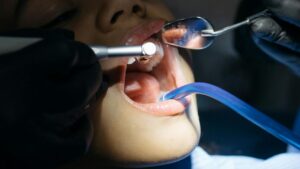A black spot on your tooth can be alarming. Whether it’s a small black spot on a molar or a black dot near the gum line, it’s a visual cue that something may be wrong—or at least worth investigating. A tiny black spot on tooth with no pain may seem harmless, but ignoring it could lead to more serious dental issues. In this comprehensive guide, we’ll cover everything from causes and symptoms to prevention and treatment of black spots on teeth.
- What Is a Black Spot on Tooth?
- Common Causes of Black Spots on Teeth
- How to Identify a Black Spot: Key Signs & Symptoms
- Diagnosis: When and Why to See a Dentist
- Treatment Options for Black Spots on Teeth
- Prevention Tips: How to Keep Black Spots Away
- Related Conditions and How to Differentiate Them
- Myth-Busting: Common Misconceptions About Black Tooth Spots
- Real Case Insight
- Frequently Asked Questions (FAQs)
- Conclusion: Don’t Ignore a Black Spot on Your Tooth
What Is a Black Spot on Tooth?
A black spot on a tooth is usually a sign of discoloration or decay. These spots may appear on the surface, near the gum line, or even on the side or top of the tooth. Some people might notice a black spot on the front tooth, while others might find it at the back molars. The severity can vary from simple staining to deep cavities.
Don’t Miss: Black Dot on Tooth: Causes, Signs & Treatment Tips
Common Causes of Black Spots on Teeth
There are several reasons why a black spot may appear on your tooth:
1. Tooth Decay (Cavities)
This is the most common cause of black spots. Plaque build-up on the teeth leads to acid production that corrodes enamel and forms cavities, which often appear as dark or black dots.
2. Tartar and Plaque Buildup
When plaque hardens into tartar, it can appear yellow, brown, or even black, especially near the gum line.
Note: Black spot on gums near tooth can often be linked to tartar build-up or gingival pigmentation.
3. Staining from Foods and Beverages
Tea, coffee, red wine, and dark berries can cause external tooth staining over time. These stains may settle into the microscopic crevices in the enamel.
4. Fluorosis
Excessive fluoride during childhood can lead to fluorosis, which appears as white, brown, or black spots on teeth.
5. Dental Trauma
If a tooth is damaged by trauma, internal bleeding or pulp damage can cause the tooth to darken, sometimes presenting as a black spot.
6. Amalgam Tattoos or Fillings
Silver amalgam fillings may leach into the enamel or gums, creating a black spot near the filling site or gum line.
7. Tooth Eruption Issues
Sometimes, as teeth emerge (especially molars), tiny grooves may retain food particles, forming a black appearance.
How to Identify a Black Spot: Key Signs & Symptoms
Visible Signs
- A small or large black spot on any part of a tooth
- A black spot on the side of tooth or top surface
- A black spot near the gum line (especially a black spot on tooth near gum)
- A dark mark on a front tooth affecting aesthetics
Physical Symptoms
- Sensitivity to hot, cold, or sweet foods
- Pain or discomfort while chewing
- Roughness or stickiness on the tooth surface
- No pain at all (in early stages or if it’s only staining)
Keep in Mind: Not all black spots are cavities—some may be surface stains or harmless pigmentation.
Diagnosis: When and Why to See a Dentist
While a black spot may seem minor, it’s essential to consult a dentist for proper diagnosis. Dental professionals use tools like:
- Visual exams
- Dental X-rays
- Intraoral cameras
- Caries detection dye
A dentist can differentiate between a harmless stain and a developing cavity, gum disease, or internal tooth damage.
Treatment Options for Black Spots on Teeth
Treatment depends on the cause and severity of the black spot:
1. Professional Cleaning
If the spot is due to surface stains or tartar, a routine dental cleaning and polishing will often resolve the issue.
2. Tooth-Colored Fillings
If decay is the culprit, the dentist will remove the damaged part and fill it using a composite material that matches the tooth color.
3. Fluoride Treatments
In cases of early decay, fluoride application can help remineralize the enamel and prevent progression.
4. Dental Crowns
If a large portion of the tooth is damaged, a crown may be placed to restore strength and function.
5. Root Canal Therapy
For extensive decay that reaches the pulp, root canal therapy may be necessary to remove the infected tissue.
6. Cosmetic Bonding or Veneers
If the black spot is on a front tooth and affects appearance, cosmetic bonding or veneers may be considered.
Prevention Tips: How to Keep Black Spots Away
Preventing a black spot on tooth is all about maintaining optimal oral hygiene and healthy habits:
Daily Oral Care
- Brush twice a day with fluoride toothpaste
- Use a soft-bristled toothbrush and replace it every 3 months
- Floss daily to remove debris between teeth
- Use antibacterial or fluoride mouthwash
Diet & Lifestyle Changes
- Avoid sugary snacks and beverages
- Rinse your mouth after consuming coffee, tea, or wine
- Stay hydrated to boost saliva flow, which protects enamel
Regular Dental Visits
- Schedule professional cleanings every 6 months
- Get annual dental X-rays to detect hidden issues
Tip: Early intervention is key! Don’t ignore even a tiny black spot on tooth with no pain.
Related Conditions and How to Differentiate Them
Black Spot on Gums Near Tooth
May be due to:
- Amalgam tattoo
- Melanin pigmentation
- Periodontal disease
Black Spot on Front Tooth
Often caused by trauma, staining, or decay—requires cosmetic attention due to visibility.
Tiny Black Spot on Tooth No Pain
This could be:
- Early cavity
- Surface stain
- Eruption groove (especially in children)
Black Spot on Side of Tooth vs Top of Tooth
- Side: May be harder to clean, prone to plaque buildup
- Top: Usually results from chewing forces and food traps
Myth-Busting: Common Misconceptions About Black Tooth Spots
- Myth: All black spots mean a cavity.
- Fact: Not necessarily; some are superficial stains.
- Myth: If it doesn’t hurt, it’s nothing serious.
- Fact: Cavities can be painless until advanced stages.
- Myth: Whitening toothpaste will remove black spots.
- Fact: It may remove surface stains but won’t fix decay.
Real Case Insight
“I had a black spot on my molar that didn’t hurt. My dentist found it was a cavity starting beneath the enamel. He treated it with a fluoride varnish and scheduled regular monitoring. Catching it early saved me from a root canal!”
Worth Reading: 50 Must-Know Tooth Health FAQs Answered by Experts
Frequently Asked Questions (FAQs)
Why is there a black spot on my tooth?
It could be due to staining, decay, tartar, trauma, or fluorosis. A dental evaluation is necessary for accurate diagnosis.
Can a black spot on tooth go away on its own?
If it’s a surface stain, improved oral hygiene might help. But decay or tartar will require professional treatment.
Is a black spot always a cavity?
Not always. It could also be a harmless stain or pigmentation, but cavities should be ruled out by a dentist.
What if there is a black spot on my child’s tooth?
Children are prone to early childhood caries. Schedule a dental appointment to assess and prevent progression.
Can a black spot on a tooth be something other than a cavity?
Yes, black spots on teeth aren’t always indicative of cavities. They can result from various factors, including:
Conclusion: Don’t Ignore a Black Spot on Your Tooth
A black spot on tooth—whether large, small, painless, or near the gum—should never be ignored. While it may be a simple stain, it could also indicate decay, tartar buildup, or a more serious dental issue. Early detection and treatment can prevent pain, tooth loss, and high dental costs.
Remember, oral health is a crucial part of your overall well-being. If you notice any discoloration, schedule a dental checkup right away.
Disclaimer: The content provided in this article is for educational and informational purposes only. It does not substitute professional medical advice, diagnosis, or treatment. For guidance specific to your dental condition or recovery, please consult your dentist, oral surgeon, or licensed healthcare provider.










0 Comments